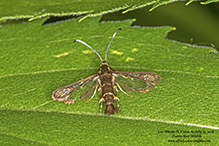Ithaca clearwing moth
(Carmenta ithacae)
Conservation • Description • Habitat • Ecology • Distribution • Taxonomy
|
||||||||
| Hodges # | 2600 |
|||||||
Conservation Status |
||||||||
| IUCN Red List | not listed |
|||||||
| NatureServe | NNR - Unranked |
|||||||
| Minnesota | not listed |
|||||||
Description |
||
Carmenta ithacae is a clearwing moth. It occurs in the United States in the east, the midwest, and the southwest. The adult strongly resembles a wasp but does not have a constricted waist. The male has a ⅝″ (15 ot 17 mm) wingspan. Female is larger, with a ⅝″ to 11 ⁄16″ (16 ot 18 mm) wingspan. The head of the male is black with a narrow, pale yellow collar. The feeler-like mouthparts (palpi) are black above and at the tip, yellow below. The antennae are metallic black with a white band before the tip. The thorax is iridescent black with a bluish reflection, a thin longitudinal stripe of yellow hairs above each wing base, and a tuft of yellow hairs on each side. The abdomen is black, shiny, and iridescent with reflections of blue, violet, or copper. At the end of abdominal segment 4 there is a narrow yellowish or whitish band. At the end of segments 2, 6, and 7 there is a narrower band or sometimes just a suggestion of a band. The bands on segments 2 and 4 are connected by a narrow line on each lower side. There is a broad, flat, fan-like tuft of long hairs at the end of the abdomen. The tuft is black with narrow white margin on each side. The forewings are long, narrow, and rounded at the tip. They are a little longer and much narrower than the hindwings. The leading edge (costal margin), inner margin, and tip all have a broad black margin, and there is a broad black horizontal band across the discal area. The margin at the tip is broadened by thin yellow lines between the veins. The rest of the wing is free of scales and transparent. The transparent area near the base of the wing is triangular. The transparent area near the tip is square. The hindwing has a narrow black margin and dark scales along the veins but is otherwise free of scales and transparent. As with most moths, the hindwings and forewings are held in contact by bristles (a frenulum) and scales (a retinaculum). Unlike most moths, they are also held together by a rolled under inner margin of the forewing coupling with a rolled up costal margin of the hindwing. On the female, the white band on the antenna is more clearly defined, and both transparent areas on the forewing are smaller. It is otherwise similar to the male. |
||
Size |
||
Male Wingspan: ⅝″ (15 ot 17 mm) Female Wingspan: ⅝″ to 11 ⁄16″ (16 ot 18 mm) |
||
Similar Species |
||
Habitat |
||
|
||
Ecology |
||
Season |
||
Late June to August |
||
Behavior |
||
|
||
Life Cycle |
||
|
||
Larva Hosts |
||
Plants in the Aster (Asteraceae) family, including common sneezeweed, false sunflower, and various asters. |
||
Adult Food |
||
|
||
Distribution |
||||
|
Sources |
|||
| 12/5/2022 | ||||
Occurrence |
||||
|
||||
Taxonomy |
|||
Order |
Lepidoptera (Butterflies and Moths) | ||
Superfamily |
Sesioidea (carpenter, leopard, goat, and allied moths) | ||
Family |
Sesiidae (clearwing moths) | ||
Subfamily |
Sesiinae | ||
Tribe |
Synanthedonini | ||
Genus |
Carmenta | ||
Synonyms |
|||
Sesia ithacae |
|||
Common Names |
|||
Ithaca clearwing moth |
|||
Glossary
Costal margin
The leading edge of the forewing of insects.
Frenulum
A spine (male) or multiple spines (female) at the base of the costal edge of the hindwing of many moths that couples with the retinaculum on the forewing to keep the wings in contact which each other.
Palp
Short for pedipalp. A segmented, finger-like process of an arthropod; one is attached to each maxilla and two are attached to the labium. They function as sense organs in spiders and insects, and as weapons in scorpions. Plural: palpi or palps.
Visitor Photos |
|||||
Share your photo of this insect. |
|||||
| This button not working for you? Simply email us at info@MinnesotaSeasons.com. Attach one or more photos and, if you like, a caption. |
|||||
Bob Payton |
|||||
See https://www.inaturalist.org/observations/123909015 |
|||||
 |
|||||
Alfredo Colon |
|||||
 |
 |
||||
 |
 |
||||
 |
|||||
MinnesotaSeasons.com Photos |
|||||
|
|||||

Slideshows |
||

Visitor Videos |
|||
Share your video of this insect. |
|||
| This button not working for you? Simply email us at info@MinnesotaSeasons.com. Attach a video, a YouTube link, or a cloud storage link. |
|||
Other Videos |
|||

Visitor Sightings |
|||||
Report a sighting of this insect. |
|||||
| This button not working for you? Simply email us at info@MinnesotaSeasons.com. Be sure to include a location. |
|||||
| Bob Payton 6/28/2022 |
Location: South Minneapolis, Howe Neighborhood See https://www.inaturalist.org/observations/123909015 |
||||
| Alfredo Colon 8/31/2018 |
Location: Woodbury, Minnesota |
 |
|||
| Alfredo Colon 6/22/2018 |
Location: Woodbury, Minnesota |
 |
|||
MinnesotaSeasons.com Sightings |
|||||
|
|||||

Created: 7/10/2019
Last Updated:

